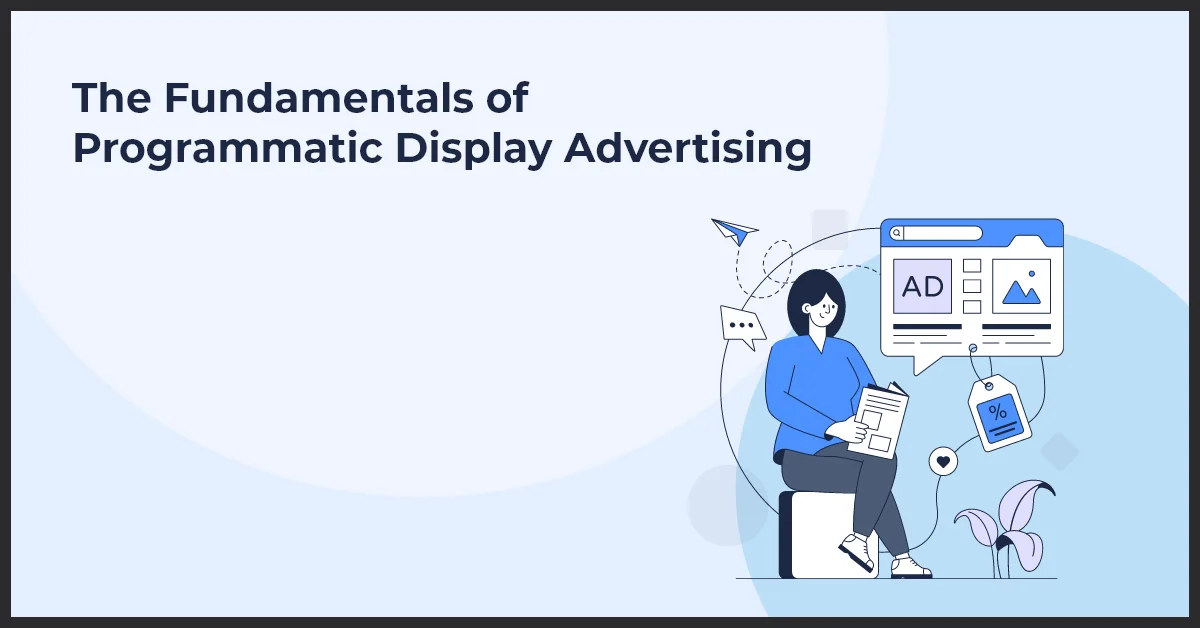The Fundamentals of Programmatic Display Advertising

Published on: June 21, 2024
Updated on: October 25, 2024
956 Views
- Digital Marketing
18 min read
Welcome to the cutting-edge world of Programmatic Display Advertising, where precision meets automation to redefine the digital marketing landscape. Diving into this subject unearths a systematic process that hinges on Real-Time Bidding (RTB) – a model that enables instantaneous auctioning of ad space to the highest bidder, ensuring that advertisements reach relevant audiences without delay.
Ad Exchanges serve as digital marketplaces where these transactions occur, seamlessly connecting buyers and sellers in the online advertising ecosystem. At the heart of this marketplace are Supply-Side Platforms (SSPs), enabling publishers to manage, sell, and optimize ad inventory with unparalleled efficiency. Conversely, Demand-Side Platforms (DSPs) offer marketers a powerful interface to purchase ad space, leveraging data and algorithms to hit their target demographics with uncanny accuracy.
The narrative of advertising has been rewritten by these advancements, shifting gears from labor-intensive, manual ad placements to sophisticated, automated systems. Integral to this transformation is the art of targeting, allowing advertisers to refine their campaigns and reach consumers with tailored messaging, thus driving engagement and maximizing return on investment.
Unlocking the Digital Display: The Programmatic Approach
The workflow of programmatic advertising may appear intricate, but clarity emerges once the process is dissected. Imagine an auction where bids are placed, won, and fulfilled in milliseconds. This is the high-velocity world of programmatic ad buying.
The Workflow of Programmatic Advertising
A sequence of automated steps defines the programmatic workflow, starting with advertisers defining target audiences, setting budgets, and creating ads. Upon a user visiting a website, a bid request is released to auction. Winning bids are determined and ads displayed, all within the blink of an eye.
Step by Step: From Advertiser to Audience
- A marketer's ad enters the programmatic ecosystem.
- User engagement with content triggers the ad placement process.
- Real-time bidding occurs, deciding which ad will be served.
- The ad is displayed to the user, completing the cycle.
How the Programmatic Auction Process Works
At the heart of programmatic advertising lies the auction process. Demand-Side Platforms (DSPs) submit ad bids on behalf of advertisers. The highest bidder wins ad space; however, the price paid is often the second-highest bid plus one cent, known as the second-price auction model.
The Key Players in the Programmatic Ecosystem
Advertisers, publishers, ad exchanges, Supply-Side Platforms (SSPs), and Demand-Side Platforms (DSPs) form the core of the programmatic ecosystem. Each entity interacts seamlessly to serve ads to relevant audiences.
Advertisers and Marketers at the Core
Determined to reach their desired audience, advertisers and marketers leverage programmatic platforms to automate the buying of digital ad space, streamlining the process and amplifying efficiency.
The Synergy Between Ad Exchanges, SSPs, and DSPs
Ad exchanges function as digital marketplaces for buying and selling ad space. SSPs enable publishers to manage and sell ad inventory, while DSPs allow advertisers to buy inventory through automated systems.
Data Management Platforms (DMPs) - The Data Backbone
DMPs consolidate user data, furnishing advertisers with insights necessary for targeted advertising. They are instrumental in the strategic segmentation and pinpointing of audiences for optimized ad effectiveness.
Introduction to Programmatic Direct and Private Marketplaces (PMPs)
Programmatic Direct and Private Marketplaces offer a more controlled environment for ad transactions. Advertisers secure premium inventory with publishers through direct negotiations, elevating the quality and placement of their advertisements.
Enhancing Ad Performance: Targeting Techniques and Dynamic Creative Optimization (DCO)
Delving into the realm of programmatic display advertising reveals a variety of strategies to amplify ad performance. Among these strategies, targeting techniques and Dynamic Creative Optimization (DCO) stand out by transforming how ads connect with audiences.
Breaking Down Targeting Techniques
Targeting techniques refine the delivery of display ads to align with specific audiences. By utilizing data and analytics, advertisers can direct their messages to users based on multiple factors like demographic details, interests, and online behaviors. This precision ensures that each ad reaches those most likely to engage with it.
Audience Segmentation and Its Relevance
Audience segmentation categorizes potential customers into groups for tailored advertising campaigns. The process leverages data points such as age, gender, income level, and geographical location to create segments. Customizing messages for each segment contributes to higher conversion rates and more efficient ad spend.
Behavioral and Contextual Targeting for Relevance
Behavioral targeting addresses users based on their browsing history and online activities, forecasting future interests and purchasing behavior. Contextual targeting places ads on websites that feature content relevant to the ad's message. Both strategies ensure ads presented are pertinent to user interests and the content they are consuming.
Exploring the Power of Dynamic Creative Optimization
Dynamic Creative Optimization (DCO) leverages algorithms to assemble personalized ads in real-time. By combining different creative elements based on a user's profile or context, DCO delivers customized and relevant ad experiences. This technology adapitates ads to a user's past interactions, weather, location, and other real-time data.
Personalizing Ads in Real-Time for Boosted Engagement
Real-time ad personalization through DCO increases engagement by presenting the most compelling message to each user. Ads adjust on the fly, reflecting the user's journey and preferences, thereby fostering stronger connections and encouraging more direct responses from potential customers.
The Strategy Behind Retargeting and Its Benefits
Retargeting revolves around re-engaging users who have previously interacted with a brand but did not complete a conversion. By displaying ads to these individuals as they browse the web, the likelihood of bringing them back to complete a purchase or action increases substantially. Retargeting not only recaptures lost opportunities but also reinforces brand recall.
- Utilize data-driven insights to shape audience segments
- Incorporate both behavioral and contextual cues for targeting precision
- Adapt creative elements in real-time through DCO for heightened relevance
- Craft retargeting campaigns to convert previous visitors into customers
By employing these elaborate techniques, advertisers can remarkably refine ad performance, create more meaningful engagements, and ultimately drive better results from their programmatic display advertising efforts.
Maximize Your Reach: Cross-Device and In-App Programmatic Strategies
With a myriad of devices at their disposal, audiences no longer tether themselves to a single screen. Cross-device advertising acknowledges this behavior, stitching together a user's journey across smartphones, tablets, and desktops. By leveraging user data, advertisers precisely target individuals, regardless of their chosen device, ensuring consistent message delivery that resonates more effectively.
The Nuances of Cross-Device Advertising Tactics
Embracing cross-device tactics involves more than recognizing multiple devices. Each device has unique usage patterns and contexts, making it essential for advertisers to craft approaches tailored to these varied experiences. For instance, smartphone users often seek immediate, location-based solutions, while desktop users might engage in more in-depth research.
The Expansion of Display Advertising into the App Ecosystem
Diving into the app ecosystem opens doors to hyper-engaged audiences. Apps account for a significant portion of mobile usage, offering a fertile ground for display advertising. Advertisers benefit from the rich, immersive environment apps provide, allowing for creative executions that capture user attention within a contextually relevant space.
Understanding In-App Advertising Dynamics
In-app advertising operates under a set of dynamics distinct from the mobile web. Interaction rates tend to be higher, but so is the expectation for seamless integration. Advertisers integrate ads that contribute to the user experience rather than disrupt. Factors such as loading times, ad relevance, and frequency must balance carefully to maintain user engagement without oversaturating the app environment with promotional content.
- Consider the distinct behavior patterns associated with different devices to optimize targeting and ad placement.
- Capitalize on the immersive nature of apps to present engaging ads that blend with user interface design and functionality.
- Utilize the deeper engagement potential of in-app advertising, mindful of the user's experience and desire for non-intrusive ads.
Safeguarding Your Ads: Ad Fraud Prevention and Maintaining Brand Safety
Ad fraud poses a significant challenge to programmatic display advertising, eating into budgets and skewing analytics. Advertisers harness sophisticated techniques and tools to mitigate these risks. Machine learning algorithms have proven effective in detecting and flagging fraudulent activity. By analyzing patterns and flagging anomalies, they prevent fake impressions and clicks from inflating campaign costs and undermining data integrity.
Dealing with Ad Fraud: Techniques and Tools
Programmatic platforms integrate fraud detection solutions to monitor traffic in real-time. Solutions such as DoubleVerify and IAS offer banner ad security, ensuring advertisers pay only for genuine interactions. These platforms assess traffic quality, sifting through vast datasets to identify bots from humans. Collaboration with industry bodies like the Trustworthy Accountability Group (TAG) reinforces defences against fraud, uniting stakeholders around common standards for a clean ad ecosystem.
Ensuring Viewability and Brand Safety Across Your Placements
Viewability measures whether ads are actually seen by users. Tools like MOAT provide detailed metrics on ad viewability, giving advertisers assurance that their ads have the chance to make an impact. Brand safety, on the other hand, ensures that ads do not appear alongside content that could harm brand reputation. Technology providers, like The Media Trust, scan and detect risky content domains, empowering advertisers to blacklist them and refine their ad placements. Contextual targeting algorithms go a step further, analyzing page content to match ads with relevant, safe environments.
- Utilize pre-bid targeting to filter out unsafe inventory before purchasing ad space.
- Incorporate post-bid reporting and analysis to review where ads were served and ensure compliance with brand safety standards.
- Engage in transparent dialogues with ad partners, seeking insights into their practices and commitment to maintaining a brand-safe advertising landscape.
Adopting these robust strategies will enhance the integrity of programmatic display campaigns and protect the investment, fostering trust in the digital advertising space.
Unveiling the Metrics: How Attribution Modeling and Analytics Power Programmatic Success
Shedding light on the effectiveness of programmatic display advertising campaigns demands a robust system for measurement — attribution modeling and analytics function as the cornerstone of this process. Assessing the path a consumer travels from initial exposure to eventual conversion, attribution modeling assigns value to each touchpoint within the programmatic advertising framework. Consequently, businesses gain insights into which ads are performing and why, enabling them to allocate budgets and craft strategies with precision.
Deciphering Attribution Modeling to Quantify Impact
Understanding attribution modeling involves recognizing the various methodologies available—from first-touch to last-touch, and from linear to time-decay models. Each offers a distinct way of crediting touchpoints with influencing user actions. For example, multi-touch attribution recognizes the complexity of the consumer journey by distributing credit across several interactions, acknowledging that each step contributes to the final decision.
The Role of Measurement and Analytics in Programmatic
Analytics go beyond mere measurement; they play a critical role in refining programmatic advertising campaigns. Real-time data analysis provides advertisers with immediate insight into campaign performance. With these analytics, advertisers can adjust bids, shift strategies, and respond to market dynamics swiftly to ensure optimal performance. Moreover, detailed analytics allow for the segmentation of audiences into more precise groups, refining targeting strategies and enhancing the relevance of ads served.
- Comprehensive analytics platforms can trace a variety of metrics, such as click-through rates, conversion rates, and return on ad spend (ROAS).
- By analyzing this data, advertisers identify high-performing segments and pour resources into what works best, hence driving better returns.
- Advanced analytics can also uncover patterns in behavior and preferences, informing future creative strategies and targeting methodologies.
Powerful as these tools are, they must be paired with skilled interpretation. Human insights drawn from this wealth of data are critical in shaping campaigns that resonate with audiences and meet business goals. Through the clever use of analytics and attribution modeling, programmatic display advertising not only scales new heights of effectiveness but also becomes more cost-efficient and impactful in the long run.
Budgeting with Confidence: Understanding Programmatic Cost Models
Programmatic display advertising operates on various cost models, each with distinct implications for budgeting strategy. Advertisers must grasp the nuances of each to allocate funds judiciously while maximizing campaign efficacy.
Exploring Cost Models: CPM, CPC, CPA
Cost-Per-Mille (CPM), Cost-Per-Click (CPC), and Cost-Per-Action (CPA) are three prevalent pricing structures in programmatic advertising. CPM charges advertisers per thousand impressions, presenting a suitable model for campaigns focused on brand awareness. As impressions accumulate, visibility escalates, albeit without guaranteeing engagement or conversion.
CPC involves a payment each time an ad is clicked, making it a compelling choice for driving traffic to a website. This model aligns costs with the potential for direct engagement, ensuring advertisers pay only for expressed audience interest.
Meanwhile, CPA goes a step further by charging only when a specific action, such as a sale or lead generation, occurs. High accountability for results makes CPA ideal for performance-centered campaigns, where immediate ROI is paramount.
How to Choose the Right Cost Model for Your Campaigns
Deciding on the optimal cost model hinges on campaign objectives. If reaching a wide audience is a priority, CPM may be the pathway. Acknowledge, however, that a high number of impressions does not equate to actions such as clicks or conversions. In scenarios where interaction is the goal, CPC allows for the payment structure to reflect engagement levels directly. CPA, contrastingly, provides a safety net where payment corresponds with completed actions aligned with campaign targets.
Selecting the correct model also depends on the depth of an advertiser's understanding of their audience and the clarity of campaign goals. A well-defined strategy resonates more effectively with each impression, click, or conversion, thereby efficiently utilizing the allocated budget.
Future-Proofing Advertising: GDPR, AI, and Programmatic Trends
Dealing with Cookies, Tracking Technologies, and GDPR
With the introduction of the General Data Protection Regulation (GDPR), advertisers must adapt to ensure compliance. The regulation dictates stricter handling of personal data, directly impacting the use of cookies and tracking technologies. Advertisers need to gain explicit consent from users to collect and process their data. Non-compliance leads to substantial penalties. Consequently, programmatic platforms are evolving to provide solutions that respect user privacy while still delivering targeted advertising.
Leveraging AI and Machine Learning to Elevate Programmatic Ads
Artificial intelligence (AI) and machine learning increasingly play pivotal roles in optimizing programmatic advertising. These technologies process vast datasets to forecast consumer behavior, enabling more accurate targeting and real-time bidding adjustments. The incorporation of AI enhances the efficiency of ad campaigns and enables marketers to provide personalized experiences at scale. Furthermore, machine learning algorithms continuously learn and improve, suggesting that future programmatic platforms will become even more intuitive and effective over time.
Programmatic TV and Video Advertising: The New Frontier
The expansion of programmatic into TV and video advertising represents a significant shift. Traditional broadcasters are turning to programmatic methods to sell advertising slots, offering advertisers better targeting and measurement capabilities similar to those in digital advertising. As more consumers embrace streaming services, programmatic TV and video advertising is set to grow, providing opportunities for advertisers to reach audiences across multiple screens and formats.
Anticipating Future Trends in Programmatic Advertising
To stay ahead, advertisers and marketers must keep a close eye on emerging trends within the programmatic space. Increasing concerns about privacy point toward greater use of first-party data and potential development of new identity solutions to replace third-party cookies. Voice search, augmented reality, and virtual reality advertising are poised to become new arenas for programmatic ads. Moreover, transparency in programmatic transactions will remain a central issue, driving demand for clearer metrics and supply chain accountability. Staying attuned to these trends will guide marketers in making informed decisions in a rapidly evolving digital landscape.
Unlocking the Horizontal Market of Programmatic Display
The Ins and Outs of Header Bidding
Header bidding emerged as a transformative technique in programmatic display advertising, empowering publishers to offer their inventory to several ad exchanges before making calls to their ad servers. This strategy allows multiple demand sources to bid on the same inventory simultaneously, typically resulting in higher revenue for publishers. Advertisers, in turn, gain access to premium inventory and a more transparent market.
Implementing header bidding scripts directly into the webpage's header, publishers can receive bids from various advertisers before the page loads. This process may seem technically intricate; however, with the right technical expertise, incorporating header bidding can be a seamless experience. The outcome of a successful implementation is a leveled playing field where the highest bid usually wins the available ad space.
Contrast this with traditional waterfall bidding, and the advantage is clear. Header bidding reduces the time and potential for lost bid opportunities, ensuring a democratic and efficient system that maximizes revenue and fills rates for publishers, while affording advertisers equal opportunity to compete for ad spaces.
Exploring Upcoming Innovations in Programmatic
- Advancements in machine learning algorithms are facilitating more sophisticated bid optimization, leading to enhanced campaign performance and ROI.
- Integration of block-chain technology offers potential solutions to combat ad fraud, providing a transparent and secure environment for advertisers and publishers alike.
- The rise of 5G technology is set to bolster programmatic's foothold, offering faster data processing and real-time bidding transactions, reducing latency, and improving user experiences.
- Connected TV (CTV) and Over-the-Top (OTT) services open new avenues for programmatic ads, leading to a surge in demand for ad inventory in these mediums.
Advancements such as these not only influence the way programmatic display advertising is practiced but also its effectiveness. The dynamic nature of technological innovation means advertisers and publishers must remain agile, adopting new methods and tools to stay ahead of the curve.
Adopting these advanced practices and keeping abreast of innovations ensures a robust, forward-looking programmatic strategy. Leveraging such strategies typically leads to heightened performance, signaling the endless potential of what can be attained with a finger on the pulse of programmatic advancements.
Unleashing Programmatic's Power for Strategic Marketing Success
As advertisers seek to maximize the impact of every dollar, incorporating programmatic display into a broader marketing strategy unlocks a new realm of efficiency and engagement. When leveraged effectively, programmatic becomes a cornerstone of modern digital campaigns.
How Markmaking Can Leverage Programmatic for Enhanced Outcomes
Markmakers who employ programmatic display advertising harness a wealth of data analytics and targeting capabilities, yielding campaigns that resonate deeply with audiences. Programmatic platforms use real-time bidding, data-driven insights, and automated ad buying to place your ads in optimal spaces where they will engage the right consumers. Aligning programmatic ad buys with strategic marketing objectives tailors the customer experience, fostering meaningful interactions that propel potential customers through the sales funnel.
Interconnecting with the Broader Advertising Ecosystem and Partnerships
Fostering connections within the broader advertising ecosystem amplifies the effectiveness of programmatic display campaigns. Collaboration with publishers, ad networks, and technology providers enhances access to premium inventory and innovative ad formats. These partnerships facilitate a more cohesive cross-channel presence, ensuring consistent messaging. Programmatic’s agility allows for swift adaptation to the evolving landscape, securing advantageous positions for ad placements and capitalizing on emergent opportunities that align with target market behaviors.
- Data Synergy: Unifying programmatic data with CRM and third-party databases sharpens audience targeting and custom-tailored messaging.
- Creative Optimization: Leveraging programmatic's dynamic creative optimization personalizes ad content in real time, boosting engagement and conversion rates.
- Seamless Integration: Programmatic display campaigns integrate smoothly with other digital marketing efforts, enriching overall campaign performance and providing a comprehensive multi-channel experience.
Adherents of programmatic display advertising are positioned at the forefront of advertising innovation, matching pace with a rapidly evolving digital ecosystem. Strategic integration of programmatic tactics elevates the brand presence and nurtures customer relationships through intelligent ad placements and informative engagement metrics.
Charting the Digital Course: Automation and Precision at Your Fingertips
With the advent of programmatic display advertising, advertisers now harness unrivaled efficiency and precision in campaign management. Streamlining the ad buying process, these systems leverage algorithms and real-time bidding to place ads effectively. Advertisers benefit from optimized targeting, dynamic creative possibilities, and actionable analytics, leading to significantly improved return on investment.
Benefits Firmly in the Spotlight
Programmatic display advertising extends its advantages to marketers by offering unprecedented granular control over advertising efforts. These platforms provide advanced analytics, which inform strategy adjustments in real time, sharpen audience targeting, and enhance engagement rates. Moreover, embracing programmatic advertising equates to embracing scalability. Campaigns easily proliferate across various devices and formats, achieving comprehensive reach with minimized wasted impressions.
On the Horizon: Foreseeing Programmatic Innovations
As the landscape of digital advertising evolves, so does programmatic display advertising. Continuous innovation in artificial intelligence and the expanding scope of data privacy regulations will shape future strategies. Advertisers should anticipate and adapt to emerging trends, furthering the integration of programmatic advertising into comprehensive digital marketing plans.
Embracing programmatic advertising involves recognizing its valuable capacity for time-efficient and cost-effective campaign execution. Advertisers who adopt programmatic approaches benefit from automated bidding environments that facilitate market entry while remaining budget-conscious. This progression will refine the capabilities of advertisers, setting a benchmark for future digital advertising ventures.
Next Steps: The Programmatic Journey Awaits
Are you ready to pilot your way through the digital advertising space with precision and agility? Adopting a programmatic approach means aligning with an ever-changing, data-driven marketing world where consumer engagement peaks. Knowing your next step can be as simple as deciding to leverage these sophisticated tools to devise, launch, and optimize campaigns that resonate with your audience.
Opportunities afforded through programmatic display advertising await marketers ready to enhance their campaigns. With the potential for increased relevance, efficiency, and comprehensive campaign analysis, the time to explore and master these tools is now. Programmatic advertising does not just offer a brighter future — it delivers a transformative present.
Frequently Asked Questions
Programmatic display advertising is the automated process of buying and selling digital ad space using software and algorithms, allowing for real-time ad placements across various websites and platforms.
Unlike traditional advertising, which involves manual negotiations and direct deals, programmatic advertising uses automated systems to buy ad space in real-time, enhancing efficiency and targeting precision.
Benefits include improved targeting, real-time optimization, cost efficiency, scalability, transparency, and enhanced ability to measure and analyze campaign performance.
Targeting is achieved using data from cookies, browsing history, demographic information, and third-party data sources to deliver ads to specific audiences based on their behavior and preferences.
Future trends include increased use of AI and machine learning, growth in programmatic TV and audio, advancements in data privacy and transparency, and the rise of omnichannel programmatic strategies.



